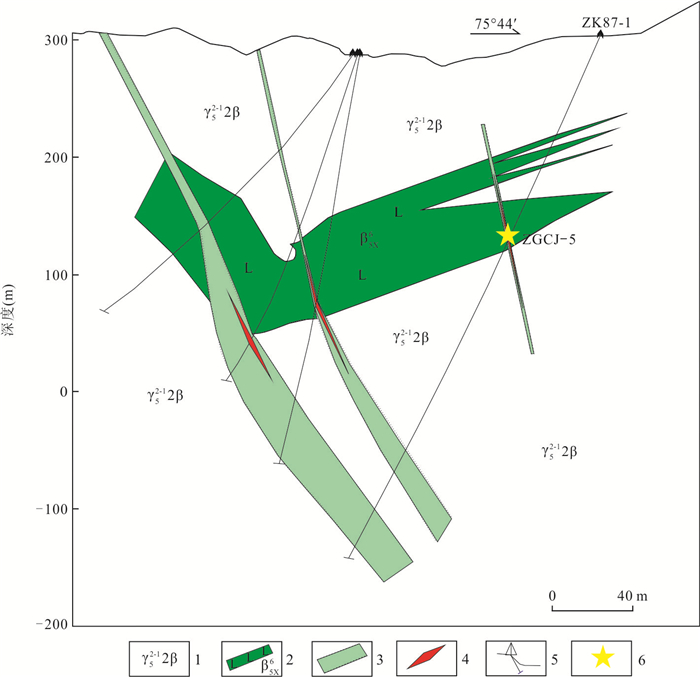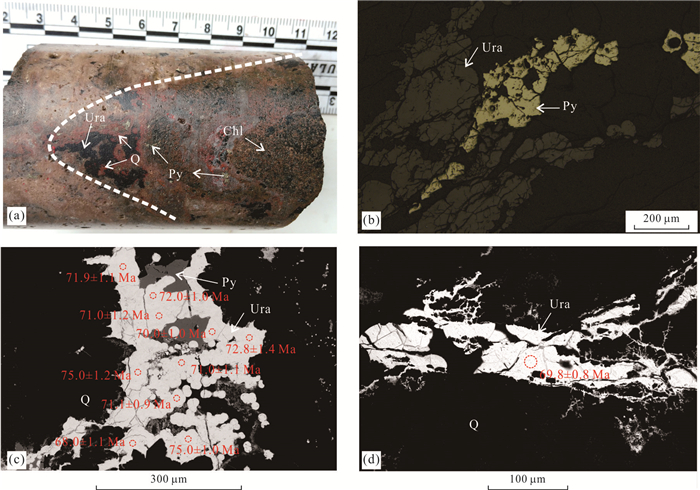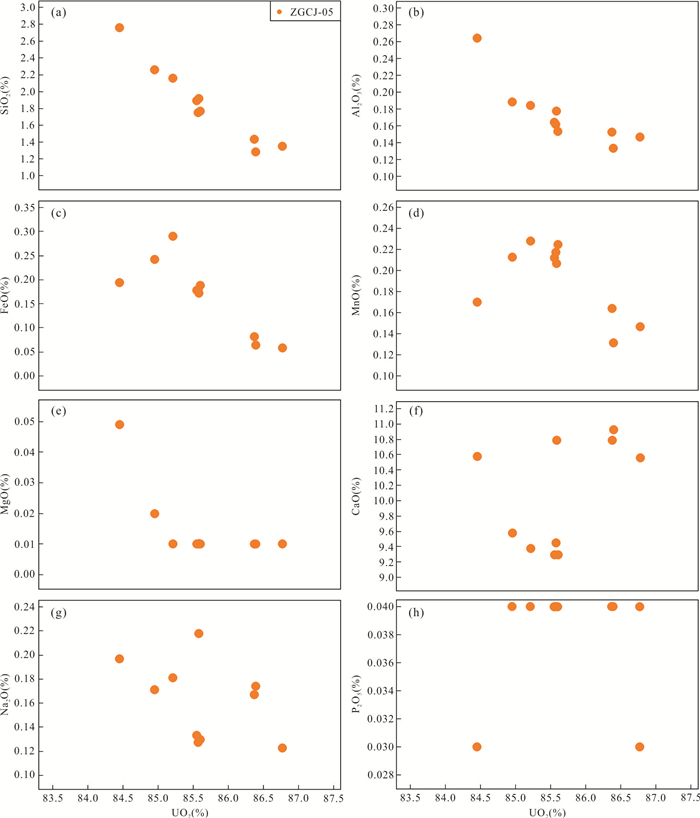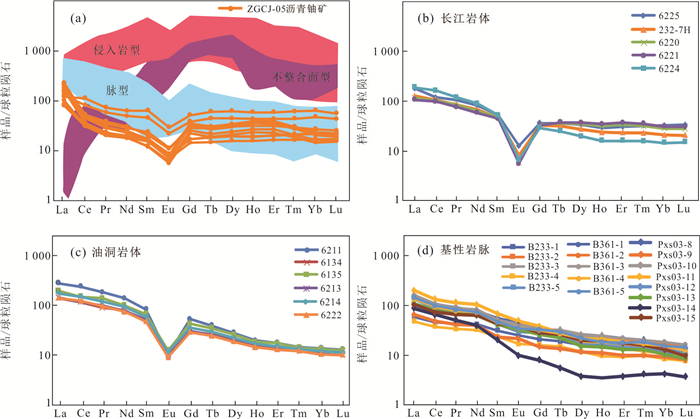In-Situ U-Pb Age and Elemental Characteristics of Pitchblende in Shulouqiu Uranium Deposit and Its Geological Significance
-
摘要: 为深入研究华南长江铀矿田内“交点型”铀矿化类型,对书楼丘矿床中位于基性岩脉与硅化碎裂岩交切部位的沥青铀矿开展原位微区U-Pb定年及元素成分研究.激光剥蚀电感耦合等离子体质谱分析结果显示,书楼丘沥青铀矿的U-Pb加权平均年龄为71.3±1.1 Ma;微量元素以富集W、Bi、Mo等亲硫元素,亏损Nb、Ta、Zr、Hf、Th等高场强元素为特征;稀土元素配分模式表现为轻稀土微富集,轻重稀土分异不明显,总量较低,Eu呈现明显的负异常,与富铀围岩长江岩体的稀土元素配分模式基本一致,暗示其铀源可能主要与长江岩体关系密切,与脉型铀矿床稀土元素配分模式的对比及ΣREE-(U/Th)、ΣREE-(LREE/HREE)N图解指示其为低温、中低盐度热液成因,δCe值指示沥青铀矿的成矿环境为还原环境.矿床内“交点型”铀成矿作用主要受南雄断裂80~60 Ma期间拉张活动、产铀长江花岗岩体和基性岩脉的共同控制,进而在交切的构造部位形成了铀矿化信息.
-
关键词:
- “交点型”铀矿化 /
- LA-ICP-MS原位分析 /
- U-Pb定年 /
- 元素分析 /
- 书楼丘矿床
Abstract: In order to penetrate into discussion the "intersection type" uranium mineralization in the Changjiang uranium ore field, South China. Here, it collected representative samples from geological structure that formed during the process of mafic dick penetrating silicified surrounding rock and then carried out a study applying in-situ U-Pb dating and elementary analysis via LA-ICP-MS system. Results show that the weighting average age of pitchblende in this region is 71.3±1.1 Ma. Besides, trace elements are characterized by the enrichment of sulfophilic elements (such as W, Bi, and Mo) and by the depletion of high field strength elements (like Nb, Ta, Zr, Hf, and Th). The signature of rare earth element (REE) curve shows low total amount with negative Eu anomalies, slight enrichment in light REE, and indistinct fractionation between light and heavy REEs. The uranium source of pitchblende probably relates to the Changjiang granite, as indicated by a REE pattern comparison between them. In addition, the pitchblende was formed under low-temperature and low-middle salinity condition. This is validated through a combination of ΣREE-(U/Th) plot, ΣREE-(LREE/HREE)N plot, and comparison against REE distribution pattern in vein-type uranium deposits. Moreover, δCe value indicates reducing environment. In this region, the pitchblende was controlled by the interplay among Nanxiong fault (during 80-60 Ma), uranium-rich Changjiang granite, and mafic dyke, therefore forming the "intersection type" uranium mineralization in the active region. -
图 6 长江铀矿田沥青铀矿电子探针主量元素成分与UO2相关图
红色投影点为棉花坑矿床样品,蓝色投影点为书楼坵矿床样品,绿色投影点为长排矿床样品;数据来源据钟福军等(2019b)
Fig. 6. The correlation diagram of pitchblende major elements and UO2 of Changjiang uranium ore field by EPMA
图 7 书楼丘铀矿区沥青铀矿ΣREE-(U/Th)(a)和ΣREE-(LREE/HREE)N图解(b)
a.底图据Frimmel et al.(2014);b.底图据Mercadier et al.(2011)
Fig. 7. The ΣREE vs. U/Th (a) and ΣREE vs. (LREE/HREE)N (b) discrimination diagrams of the pitchblende
图 8 沥青铀矿的球粒陨石标准化稀土元素配分图
稀土元素的数据来源:长江、油洞岩体和基性岩脉朱捌(2010),不同类型铀矿床引自Mercadier et al.(2011);标准化值据Sun and McDonough(1989)
Fig. 8. Chondrite-normalized REE patterns diagrams for the picthblende
表 1 书楼丘地区矿石矿物类型和矿物组合
Table 1. Ore mineral types and mineral combinations in Shulouqiu area
热液矿物 矿物组合 铀矿物 金属矿物 脉石矿物 成矿前 成矿阶段 成矿后 主要 次要 主要 次要 主要 次要 Ⅰ Ⅱ Ⅲ 沥青铀矿 钛铀矿 黄铁矿 方铅矿 石英 萤石 红棕色、白色石英为主 紫黑色萤石-黄铁矿-沥青铀矿 粉红色方解石-黄铁矿-沥青铀矿 赤红色微晶石英-黄铁矿-沥青铀矿 灰白色方解石、梳妆石英、灰白色石英为主 氧化沥青铀矿 赤铁矿 黄铜矿 水云母 方解石 铀钍矿 闪锌矿 绿泥石 表 2 书楼丘铀矿床沥青铀矿LA-ICP-MS U-Pb同位素分析结果
Table 2. U-Pb isotope compositions of uraninite in the Shulouqiu uranium deposites by LA-ICP-MS.
测点编号 207Pb/206Pb 207Pb/235U 206Pb/238U 207Pb/206Pb 207Pb/235U 206Pb/238U 比值 1σ 比值 1σ 比值 1σ 年龄(Ma) 1σ 年龄(Ma) 1σ 年龄(Ma) 1σ ZGCJ-5 01 0.049 6 0.004 6 0.081 2 0.007 7 0.011 2 0.000 2 176.0 200.0 79.0 7.2 71.9 1.1 02 0.050 8 0.004 7 0.076 8 0.007 0 0.011 2 0.000 2 232.0 15.7 75.0 6.5 72.0 1.0 03 0.052 0 0.004 2 0.078 6 0.006 4 0.011 1 0.000 2 287.0 180.5 77.0 6.0 71.1 0.9 04 0.048 3 0.003 4 0.072 0 0.005 2 0.010 9 0.000 1 122.0 150.0 71.0 4.9 69.8 0.8 05 0.047 9 0.005 7 0.074 1 0.008 7 0.011 3 0.000 2 100.0 250.0 73.0 8.1 72.0 1.1 06 0.049 9 0.006 8 0.075 4 0.010 7 0.011 1 0.000 2 187.0 292.5 74.0 10.0 71.0 1.2 07 0.046 6 0.008 0 0.069 9 0.010 8 0.010 6 0.000 2 28.0 370.3 69.0 10.2 68.0 1.1 08 0.047 9 0.005 1 0.071 5 0.007 7 0.010 9 0.000 2 100.0 227.7 70.0 7.3 70.0 1.0 09 0.049 1 0.006 7 0.078 0 0.010 5 0.011 7 0.000 2 150.0 292.5 76.0 9.9 75.0 1.2 10 0.047 6 0.005 7 0.076 1 0.008 2 0.011 1 0.000 2 80.0 259.2 74.0 7.7 71.0 1.1 11 0.050 0 0.003 7 0.078 7 0.005 7 0.011 7 0.000 2 195.0 174.0 77.0 5.4 75.0 1.0 12 0.046 9 0.005 0 0.078 0 0.008 7 0.011 4 0.000 2 56.0 224.0 76.0 8.1 72.8 1.4 13 0.047 6 0.008 1 0.077 2 0.012 6 0.011 5 0.000 2 80.0 359.2 76.0 11.9 74.0 1.2 14 0.046 9 0.005 5 0.069 7 0.007 7 0.010 8 0.000 2 43.0 259.2 68.0 7.3 69.2 1.1 15 0.047 7 0.005 9 0.073 6 0.009 0 0.010 9 0.000 1 83.0 270.3 72.0 8.5 69.8 0.8 表 3 书楼丘矿床沥青铀矿LA-ICP-MS主量元素(%)、微量元素(10-6)分析结果
Table 3. Major and Trace element composition of pitchblende from the Shulouqiu ore deposit by LA-ICP-MS
样品号 ZGCJ-5-16 ZGCJ-5-17 ZGCJ-5-18 ZGCJ-5-19 ZGCJ-5-20 ZGCJ-5-21 ZGCJ-5-22 ZGCJ-5-23 ZGCJ-5-24 ZGCJ-5-25 Na2O 0.20 0.12 0.17 0.22 0.17 0.13 0.13 0.17 0.13 0.18 SiO2 2.75 1.35 1.43 1.91 1.28 1.89 1.76 2.26 1.75 2.15 FeO 0.19 0.06 0.08 0.17 0.06 0.18 0.19 0.24 0.18 0.29 UO2 84.45 86.77 86.38 85.58 86.39 85.55 85.6 84.96 85.58 85.21 CaO 10.57 10.56 10.78 10.79 10.92 9.29 9.29 9.57 9.45 9.37 MgO 0.05 0.01 0.01 0.01 0.01 0.01 0.01 0.02 0.01 0.01 Al2O3 0.26 0.15 0.15 0.18 0.13 0.16 0.15 0.19 0.16 0.18 P2O5 0.03 0.03 0.04 0.04 0.04 0.04 0.04 0.04 0.04 0.04 K2O 0.03 - 0.01 0.02 0.01 - - 0.02 — 0.02 MnO 0.17 0.15 0.16 0.21 0.13 0.21 0.22 0.21 0.22 0.23 Total 98.70 99.20 99.21 99.12 99.15 97.47 97.40 97.67 97.50 97.69 Sr 168.57 118.12 131.05 170.84 114.66 118.58 117.78 150.35 118.29 160.03 Cs 8.66 1.59 2.97 3.5 1.62 2.04 1.89 4.76 1.93 4.49 Rb 5.32 0.86 1.78 2.64 1.22 0.93 0.77 2.81 0.84 2.61 Ba 27.38 18.17 19.34 26.46 16.70 16.07 16.19 21.23 16.37 23.75 Nb 0.02 0.02 0.02 0.03 0.03 - 0.01 0.01 0.01 0.01 Zr 0.02 0.06 0.04 0.02 0.03 0.06 0.06 0.04 0.05 0.05 Be 40.28 34.64 36.73 42.74 31.41 42.69 44.61 46.42 43.7 45.97 Sc 0.30 0.27 0.32 0.62 0.73 0.09 0.09 0.11 0.08 0.19 V 64.89 60.70 61.43 68.83 54.26 229.76 259.79 221.37 242.89 226.63 Cr 4.92 6.67 3.06 2.99 4.50 3.50 2.14 3.83 2.00 10.85 W 1 285.55 1 089.78 1 157.28 1 547.82 1 143.94 2 591.28 2 730.1 2 583.02 2 657.55 2 658.69 Mo 79.62 81.34 79.25 71.85 71.24 148.77 142.96 146.14 141.94 139.87 Bi 197.22 276.44 277.19 476.65 848.35 423.10 442.13 386.17 475.45 494.55 Tl 0.83 0.15 0.19 0.55 0.21 0.11 0.14 0.34 0.12 0.30 Ag 0.61 0.37 0.27 0.77 0.48 0.03 0.04 0.08 0.03 0.21 Pb 8 804.02 4 854.02 4 668.46 4 574.95 4 471.41 17 416.70 17 748.97 15 730.92 16 968.03 15 236.69 Th 0.001 3 0.000 4 - - - 0.000 5 - 0.000 5 - - Zn 3.32 3.32 3.32 3.32 3.32 3.32 3.32 3.32 3.32 3.32 Cu 0.37 0.11 0.17 0.32 0.19 0.73 0.91 1.13 0.88 0.89 Co 0.04 0.04 0.04 0.02 0.05 0.09 0.10 0.09 0.12 0.11 Ni 0.08 0.08 0.03 0.05 0.07 - 0.09 0.03 - 0.06 La 23.86 18.74 19.99 30.74 28.43 42.00 53.10 37.44 48.34 49.86 Ce 19.07 19.05 20.67 49.57 68.50 22.27 29.06 21.58 27.55 32.32 Pr 2.15 1.91 2.15 5.54 6.90 2.15 2.88 2.23 2.72 3.63 Nd 8.60 8.42 9.25 23.1 29.3 8.37 11.65 8.71 10.64 14.28 Sm 2.37 2.65 2.61 6.95 9.84 1.90 2.63 1.84 2.46 3.14 Eu 0.41 0.46 0.50 1.29 1.71 0.36 0.48 0.33 0.43 0.64 Gd 2.98 3.48 3.49 7.84 10.6 5.30 7.16 4.54 6.54 6.56 Tb 0.56 0.71 0.69 1.66 2.26 0.82 1.14 0.71 1.01 1.10 Dy 4.01 4.97 4.96 11.40 15.90 6.10 8.65 5.41 7.66 8.24 Ho 0.90 1.08 1.11 2.46 3.34 1.51 2.20 1.33 2.03 2.06 Er 2.73 3.45 3.31 7.21 9.80 4.41 6.43 3.76 5.63 5.97 Tm 0.42 0.55 0.53 1.11 1.57 0.53 0.77 0.47 0.70 0.75 Yb 2.93 3.93 3.69 8.06 10.9 2.80 3.98 2.49 3.48 3.94 Lu 0.44 0.55 0.53 1.10 1.42 0.39 0.57 0.39 0.48 0.53 ΣREE 71.42 69.94 73.46 157.97 200.46 98.92 130.69 91.24 119.68 133.00 LREE 56.45 51.23 55.17 117.15 144.65 77.05 99.79 72.13 92.13 103.86 HREE 14.79 18.71 18.29 40.82 55.81 21.87 30.90 19.11 27.54 29.14 (LREE/HREE)N 1.52 1.07 1.18 1.11 0.97 1.53 1.39 1.61 1.43 1.52 (La/Yb)N 5.84 3.42 3.88 2.74 1.87 10.77 9.57 10.80 9.96 9.08 (La/Sm)N 6.49 4.56 4.94 2.86 1.87 14.29 13.04 13.16 12.71 10.25 (Gd/Yb)N 0.84 0.73 0.78 0.81 0.80 1.57 1.49 1.51 1.55 1.38 δEu 0.47 0.47 0.51 0.53 0.51 0.33 0.32 0.33 0.31 0.42 δCe 0.51 0.63 0.63 0.86 1.16 0.36 0.37 0.39 0.39 0.42 注:“-”表示元素含量低于仪器检测限. -
Brugger, J., Etschmann, B., Chu, Y.S., et al., 2006. The Oxidation State of Europium in Hydrothermal Scheelite: In Situ Measurement by Xanes Spectroscopy. The Canadian Mineralogist, 44(5): 1079-1087. https://doi.org/10.2113/gscanmin.44.5.1079 Cao, H.J., Huang, G.L., Xu, L.L., et al., 2013. The Ar-Ar Age and Geochemical Characteristics of Diabase Dykes of the Youdong Fault Zone in South of Zhuguang Granite Pluton. Acta Geologica Sinica, 87(7): 957-966(in Chinese with English abstract). Chen, Y.W., Bi, X.W., Hu, R.Z., et al., 2012. Element Geochemistry, Mineralogy, Geochronology and Zircon Hf Isotope of the Luxi and Xiazhuang Granites in Guangdong Province, China: Implications for U Mineralization. Lithos, 150: 119-134. https://doi.org/10.1016/j.lithos.2012.06.025 Chen, Y.W., Hu, R.Z., Luo, J.C., et al., 2019. In-Situ Mineral Chemistry and Chronology Analyses of the Pitchblende in the Shazijiang Uranium Deposit and Their Implications for Mineralization. Acta Petrologica Sinica, 35(9): 2679-2694(in Chinese with English abstract). doi: 10.18654/1000-0569/2019.09.04 Cheng, H.H., Du, L.T., 1998. Study on Heavy Minerals of Some Uranium Deposits. Uranium Geology, 14(1): 26-31(in Chinese with English abstract). http://search.cnki.net/down/default.aspx?filename=YKDZ199801006&dbcode=CJFD&year=1998&dflag=pdfdown Cuney, M., 2009. The Extreme Diversity of Uranium Deposits. Mineralium Deposita, 44(1): 3-9. https://doi.org/10.1007/s00126-008-0223-1 Cuney, M., 2010. Evolution of Uranium Fractionation Processes through Time: Driving the Secular Variation of Uranium Deposit Types. Economic Geology, 105(3): 553-569. https://doi.org/10.2113/gsecongeo.105.3.553 Eglinger, A., André-Mayer, A.S., Vanderhaeghe, O., et al., 2013. Geochemical Signatures of Uranium Oxides in the Lufilian Belt: From Unconformity-Related to Syn-Metamorphic Uranium Deposits during the Pan-African Orogenic Cycle. Ore Geology Reviews, 54: 197-213. https://doi.org/10.1016/j.oregeorev.2013.04.003 Feng, Z.J., Lai, Z.X., Mo, J.H., et al., 2016. A Study of Metallogenic Mechanism of "Intersection" Type Uranium Deposit and Exploration Thinking of Xiazhuang Orefield. Mineral Deposits, 35(5): 1047-1061(in Chinese with English abstract). http://en.cnki.com.cn/Article_en/CJFDTOTAL-KCDZ201605012.htm Frimmel, H.E., Schedel, S., Brätz, H., 2014. Uraninite Chemistry as Forensic Tool for Provenance Analysis. Applied Geochemistry, 48: 104-121. https://doi.org/10.1016/j.apgeochem.2014.07.013 Guo, C.Y., Qin, M.K., Xu, H., et al., 2020. Age of Zhangjia Uranium Deposit in the Miaoershan Ore Field, Guangxi Autonomous Region, China: In Situ Micro-Determination on Pitchblende. Earth Science, 45(1): 72-89(in Chinese with English abstract). https://doi.org/10.3799/dqkx.2018.227 Huang, G.L., Cao, H.J., Ling, H.F., et al., 2012. Zircon SHRIMP U-Pb Age, Geochemistry and Genesis of the Youdong Granite in Northern Guangdong. Acta Geologica Sinica, 86(4): 577-586(in Chinese with English abstract). http://www.researchgate.net/publication/303160698_Zircon_SHRIMP_U-Pb_age_geochemistry_and_genesis_of_the_Youdong_granite_in_northern_Guangdong Huang, G.L., Liu, X.Y., Sun, L.Q., et al., 2014. Zircon U-Pb Dating, Geochemical Characteristic and Genesis of the Changjiang Granite in Northern Guangdong. Acta Geologica Sinica, 88(5): 836-849(in Chinese with English abstract). Huang, G.L., Wu, L.Q., Deng, P., et al., 2006. Prospecting Potential and Direction for Granite Uranium Deposit in North Guangdong, China. Uranium Geology, 22(5): 267-275(in Chinese with English abstract). http://en.cnki.com.cn/Article_en/CJFDTOTAL-YKDZ200605001.htm Huang, G.L., Yin, Z.P., Ling, H.F., et al., 2010. Formation Age, Geochemical Characteristics and Genesis of Pitchblende from No. 302 Uranium Deposit in Northern Guangdong. Mineral Deposits, 29(2): 352-360(in Chinese with English abstract). http://www.researchgate.net/publication/313038009_Formation_age_geochemical_characteristics_and_genesis_of_pitchblende_from_No_302_uranium_deposit_in_northern_Guangdong Lai, J., Qi, J.M., Chen, J.J., et al., 2020. Uranium Micromineralogy and Geochronology of the Jiangtou Uranium Ore Field in the Qingzhangshan Granite Pluton, North Guangdong: Constraints on the Genetic Relationship with Metallogenic Dynamic Background. Acta Geologica Sinica, 94(4): 1128-1142(in Chinese with English abstract). Li, X.H., Hu, R.Z., Rao, B., 1997. Geochronology and Geochemistry of Cretaceous Mafic Dikes from Northern Guangdong, SE China. Geochimica, 26(2): 14-31(in Chinese with English abstract). http://en.cnki.com.cn/Article_en/CJFDTOTAL-DQHX702.003.htm Liu, R.Z., 2003. Several Questions Discussion of Intersection-Type Uranium Deposit. Uranium Geology of South China, 20(1): 41-48(in Chinese with English abstract). Liu, Y.S., Hu, Z.C., Gao, S., et al., 2008. In Situ Analysis of Major and Trace Elements of Anhydrous Minerals by LA-ICP-MS without Applying an Internal Standard. Chemical Geology, 257(1-2): 34-43. https://doi.org/10.1016/j.chemgeo.2008.08.004 Ludwig, K.R., 2003. User's Manual for Isoplot 3.00: A Geochronological Toolkit for Microsoft Excel. Berkeley Geochronology Center, 4: 72. http://www.researchgate.net/publication/303107803_User's_manual_for_Isoplot_36_A_geochronological_toolkit_for_microsoft_excel_Berkeley_Geochronology_Center Luo, J.C., Hu, R.Z., Fayek, M., et al., 2017. Newly Discovered Uranium Mineralization at~2.0 Ma in the Menggongjie Granite-Hosted Uranium Deposit, South China. Journal of Asian Earth Sciences, 137: 241-249. https://doi.org/10.1016/j.jseaes.2017.01.021 Luo, J.C., Qi, Y.Q., Wang, L.X., et al., 2019b. Ar-Ar Dating of Mafic Dykes from the Xiazhuang Uranium Ore Field in Northern Guangdong, South China: A Reevaluation of the Role of Mafic Dyke in Uranium Mineralization. Acta Petrologica Sinica, 35(9): 2660-2678(in Chinese with English abstract). doi: 10.18654/1000-0569/2019.09.03 Luo, J.C., Shi, S.H., Chen, Y.W., et al., 2019a. Review on Dating of Uranium Mineralization. Acta Petrologica Sinica, 35(2): 589-605(in Chinese with English abstract). http://www.researchgate.net/publication/333191861_Review_on_dating_of_uranium_mineralization Mercadier, J., Cuney, M., Lach, P., et al., 2011. Origin of Uranium Deposits Revealed by Their Rare Earth Element Signature. Terra Nova, 23(4): 264-269. https://doi.org/10.1111/j.1365-3121.2011.01008.x Shi, S.H., Hu, R.Z., Wen, H.J., et al., 2010. Geochronology of the Shazijiang Uranium Ore Deposit, Northern Guangxi, China: U-Pb Ages of Pitchblende and Their Geological Significance. Acta Geologica Sinica, 84(8): 1175-1182(in Chinese with English abstract). Sun, S.S., McDonough, W.F., 1989. Chemical and Isotopic Systematics of Oceanic Basalts: Implications for Mantle Composition and Processes. Geological Society, London, Special Publications, 42(1): 313-345. https://doi.org/10.1144/gsl.sp.1989.042.01.19 Suzuki, K., Kato, T., 2008. CHIME Dating of Monazite, Xenotime, Zircon and Polycrase: Protocol Pitfalls, and Chemical Criterion of Possibly Discordant Age Data. Gondwana Research, 14(4): 569-586. https://doi.org/10.1016/j.gr.2008.01.005 Wang, L.X., Ma, C.Q., Lai, Z.X., et al., 2015. Early Jurassic Mafic Dykes from the Xiazhuang Ore District (South China): Implications for Tectonic Evolution and Uranium Metallogenesis. Lithos, 239: 71-85. https://doi.org/10.1016/j.lithos.2015.10.008 Wang, X.C., Zhang, B.T., Zhang, Z.H., 1991. A Study of the Relationship between the Dark Dyke and the Uranium Mineralization. Mineral Deposits, 10(4): 359-370(in Chinese with English abstract). http://en.cnki.com.cn/Article_en/CJFDTOTAL-KCDZ199104010.htm Wu, Y., Qin, M.K., Guo, D.F., et al., 2020. Metallogenic Chronology of the Pitchblende of 1101 Uranium Ore Area in Mouding, Middle-South Part of the Kangdian Axis and Its Geological Significance. Earth Science, 45(2): 419-433(in Chinese with English abstract). https://doi.org/10.3799/dqkx.2019.058 Xu, W.X., Fu, S.C., Xu, Y., et al., 2017. Analysis of Prospecting Potential in the Depth of Shulouqiu Uranium Deposit in Southern Zhuguangshan Pluton. Mineral Exploration, 8(5): 782-788(in Chinese with English abstract). http://en.cnki.com.cn/Article_en/CJFDTOTAL-YSJS201705008.htm Zhang, L., Chen, Z.Y., Li, X.F., et al., 2018. Zircon U-Pb Geochronology and Geochemistry of Granites in the Zhuguangshan Complex, South China: Implications for Uranium Mineralization. Lithos, 308-309: 19-33. https://doi.org/10.1016/j.lithos.2018.02.029 Zhang, S.G., 2019. Geological Characteristics, Deposit Genesis and Prospecting Potential of Shulouqiu Uranium Deposit. Uranium Mining and Metallurgy, 38(2): 157-164(in Chinese with English abstract). Zhong, F.J., Pan, J.Y., Wu, J.H., et al., 2019a. Petrogenesis and Its Relationship with Uranium Mineralization of Gabbro-Diorite in Changjiang Uranium Ore-Field, Northern Guangdong Province, China. Earth Science, 44(9): 3042-3059(in Chinese with English abstract). https://doi.org/10.3799/dqkx.2017.592 Zhong, F.J., Yan, J., Xia, F., et al., 2019b. In-Situ U-Pb Isotope Geochronology of Uraninite for Changjiang Granite-Type Uranium Ore Field in Northern Guangdong, China: Implications for Uranium Mineralization. Acta Petrologica Sinica, 35(9): 2727-2744(in Chinese with English abstract). doi: 10.18654/1000-0569/2019.09.07 Zhu, B., 2010. The Study of Mantle Liquid and Uranium Metallogenesis-Take Uranium Ore Field of South Zhuguang Mountain as an Example (Dissertation). Chengdu University of Technology, Chengdu(in Chinese with English abstract). Zong, K.Q., Chen, J.Y., Hu, Z.C., et al., 2015. In-Situ U-Pb Dating of Uraninite by Fs-LA-ICP-MS. Science in China: Earth Sciences, 45(9): 1304-1319(in Chinese). http://www.cnki.com.cn/Article/CJFDTotal-JDXG201510005.htm 曹豪杰, 黄国龙, 许丽丽, 等, 2013. 诸广花岗岩体南部油洞断裂带辉绿岩脉的Ar-Ar年龄及其地球化学特征. 地质学报, 87(7): 957-966. doi: 10.3969/j.issn.0001-5717.2013.07.005 陈佑纬, 胡瑞忠, 骆金诚, 等, 2019. 桂北沙子江铀矿床沥青铀矿原位微区年代学和元素分析: 对铀成矿作用的启示. 岩石学报, 35(9): 2679-2694. https://www.cnki.com.cn/Article/CJFDTOTAL-YSXB201909004.htm 程华汉, 杜乐天, 1998. 几个铀矿床碱交代作用中重砂矿物变化的研究. 铀矿地质, 14(1): 26-31. https://www.cnki.com.cn/Article/CJFDTOTAL-YKDZ199801006.htm 冯志军, 赖中信, 莫济海, 等, 2016. 下庄矿田"交点型"铀矿床成矿机理研究及勘查思路探讨. 矿床地质, 35(5): 1047-1061. https://www.cnki.com.cn/Article/CJFDTOTAL-KCDZ201605012.htm 郭春影, 秦明宽, 徐浩, 等, 2020. 广西苗儿山铀矿田张家铀矿床成矿时代: 沥青铀矿微区原位测定. 地球科学, 45(1): 72-89. doi: 10.3799/dqkx.2018.227 黄国龙, 曹豪杰, 凌洪飞, 等, 2012. 粤北油洞岩体SHRIMP锆石U-Pb年龄、地球化学特征及其成因研究. 地质学报, 86(4): 557-586. https://www.cnki.com.cn/Article/CJFDTOTAL-DZXE201204004.htm 黄国龙, 刘鑫扬, 孙立强, 等, 2014. 粤北长江岩体的锆石U-Pb定年、地球化学特征及其成因研究. 地质学报, 88(5): 836-849. https://www.cnki.com.cn/Article/CJFDTOTAL-DZXE201405003.htm 黄国龙, 吴烈勤, 邓平, 等, 2006. 粤北花岗岩型铀矿找矿潜力及找矿方向. 铀矿地质, 22(5): 267-275. doi: 10.3969/j.issn.1000-0658.2006.05.002 黄国龙, 尹征平, 凌洪飞, 等, 2010. 粤北地区302矿床沥青铀矿的形成时代、地球化学特征及其成因研究. 矿床地质, 29(2): 352-360. doi: 10.3969/j.issn.0258-7106.2010.02.017 赖静, 祁家明, 陈军军, 等, 2020. 粤北青嶂山岩体江头矿区铀矿微区矿物学、年代学特征及其成矿动力背景制约. 地质学报, 94(4): 1128-1142. doi: 10.3969/j.issn.0001-5717.2020.04.008 李献华, 胡瑞忠, 饶冰, 1997. 粤北白垩纪基性岩脉的年代学和地球化学. 地球化学, 26(2): 14-31. doi: 10.3321/j.issn:0379-1726.1997.02.004 刘汝洲, 2003. 浅谈交点型铀矿中的几个问题. 华南铀矿地质, 20(1): 41-48. 骆金诚, 齐有强, 王连训, 等, 2019b. 粤北下庄铀矿田基性岩脉Ar-Ar定年及其与铀成矿关系新认识. 岩石学报, 35(9): 2660-2678. https://www.cnki.com.cn/Article/CJFDTOTAL-YSXB201909003.htm 骆金诚, 石少华, 陈佑纬, 等, 2019a. 铀矿床定年研究进展评述. 岩石学报, 35(2): 589-605. https://www.cnki.com.cn/Article/CJFDTOTAL-YSXB201902019.htm 石少华, 胡瑞忠, 温汉捷, 等, 2010. 桂北沙子江铀矿床成矿年代学研究: 沥青铀矿U-Pb同位素年龄及其地质意义. 地质学报, 84(8): 1175-1182. https://www.cnki.com.cn/Article/CJFDTOTAL-DZXE201008011.htm 王学成, 章邦桐, 张祖还, 1991. 暗色岩脉与铀成矿关系研究. 矿床地质, 10(4): 359-370. https://www.cnki.com.cn/Article/CJFDTOTAL-KCDZ199104010.htm 武勇, 秦明宽, 郭冬发, 等, 2020. 康滇地轴中南段牟定1101铀矿区沥青铀矿成矿时代及成因. 地球科学, 45(2): 419-433. doi: 10.3799/dqkx.2019.058 徐文雄, 伏顺成, 许幼, 等, 2017. 诸广山岩体南部书楼丘铀矿床深部找矿潜力分析. 矿产勘查, 8(5): 782-788. doi: 10.3969/j.issn.1674-7801.2017.05.008 张善果, 2019. 书楼丘铀矿床地质特征、矿床成因及找矿潜力分析. 铀矿冶, 38(2): 157-164. https://www.cnki.com.cn/Article/CJFDTOTAL-YKYI201902015.htm 钟福军, 潘家永, 巫建华, 等, 2019a. 粤北长江铀矿田辉长闪长岩的岩石成因及其与铀成矿的关系. 地球科学, 2019(9): 3043-3059. doi: 10.3799/dqkx.2017.592 钟福军, 严杰, 夏菲, 等, 2019b. 粤北长江花岗岩型铀矿田沥青铀矿原位U-Pb年代学研究及其地质意义. 岩石学报, 35(9): 2727-2744. https://www.cnki.com.cn/Article/CJFDTOTAL-YSXB201909007.htm 朱捌, 2010. 地幔流体与铀成矿作用研究——以诸广山南部铀矿田为例(博士学位论文). 成都: 成都理工大学. 宗克清, 陈金勇, 胡兆初, 等, 2015. 铀矿Fs-LA-ICP-MS原位微区U-Pb定年. 中国科学: 地球科学, 45(9): 1304-1319. https://www.cnki.com.cn/Article/CJFDTOTAL-JDXK201509005.htm -









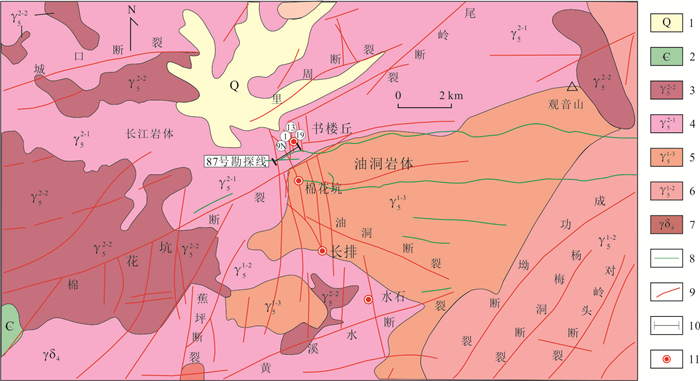
 下载:
下载:
